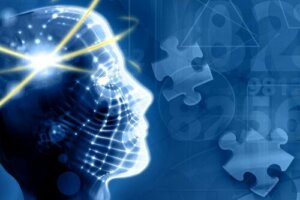Bioneuroemotion: The Relationship Between Emotions and Illness

As stated by Enric Corberá, director of the Spanish Institute of Bioneuroemotion: “Bioneuroemotion studies the biological meaning of the symptoms that manifest in our body, understanding that in nature everything is information and, in some way, this information is established through learnings in our unconscious ”.
Bioneuroemotion investigates the most optimal way to enter the unconscious in order to modify learning and manage emotions. In fact, it’s what Enric Corberá calls the ‘Art of Unlearning’.
“We get sick unconsciously, we become aware, and we heal unconsciously.”
-Enric Corbera-
Behind every emotion, there’s usually a belief in something. This forces you to act in a certain way and you have to transcend that belief to heal your life.
Albert Ellis and REBT
One of the bases of neurobioemotion is the search for irrational thoughts to heal the emotions that these thoughts produce in us. This is what Rational Emotive Behavior Therapy (REBT) created by Albert Ellis consists of.

Ellis assumed that an emotional state is caused by our interpretation of events and not by the events themselves. Therefore, if you’re able to modify your irrational beliefs and thoughts, you’ll be able to create a less painful and more rational emotional state.
Albert Ellis worked with 11 irrational beliefs. They’re as follows.
- I must be loved by everyone, or I won’t be lovable.
- I must do everything well, or I’ll be incompetent.
- I must act fairly and considerately or I’ll be a bad person.
- It’s awful when things don’t go the way I want.
- Everything that happens to me is out of my control
- I must worry about anything that’s fearful or risky.
- I must avoid responsibilities and problems if I want to be comfortable or content.
- I must depend on others as I’m not capable of running my own life.
- I must be controlled by my past and disturbed by anything that once disturbed me.
- Other people’s problems are terrible and I must get upset about them.
- There’s always a right solution and it’ll be terrible if I can’t find it.
All of these beliefs immerse you in the tyranny of “I must…” and “I should…”. This means that you do things out of obligation and without wanting to do them. It produces negative emotions in you.
The objectives of bioneuroemotion
The main objective of bioneuroemotion is to understand and influence your emotional health. Additionally, it seeks to facilitate your achievement of well-being and health, promote a holistic view of life, and connect your mind with your body and your environment.
Bioneuroemotion intends to integrate with the different social and health sciences. It aims to achieve a holistic approach to physical and emotional problems.
How does bioneuroemotion work?
Bioneuroemotion uses three techniques to find the learned information and, if possible, change it. The information is found in three brain archives.
- Chronological age. The conflicts throughout your life are analyzed until the triggering situation is found.
- The project/meaning. This is the period that covers your life from nine months before your conception to three years of age. During this period of time, the conflicts that were experienced by your parents are analyzed.
- The family tree. The dates of birth, death, illnesses, and professions of your relatives are studied. This is to look for similarities and understand where and from whom the triggering situation originates.
“Those who cannot remember the past are condemned to repeat it.”
-George Santayana-
Once the aforementioned techniques have been used, the connection between the emotion you feel and the ailment you have will come to light.
Upon discovering the emotion-illness connection, you’ll go into a quarantine state in which your mind will fight not to unlearn. Therefore, you’ll have to reflect on the process of unlearning. Once you unlearn the belief and the emotions it produces in you, your disease no longer has a cause and usually disappears.

Reaching your unconscious
To reach the emotion that an ailment produces in you, you must delve into your mind by asking yourself a series of questions:
- Where? How? Who? When? With these questions, you establish the moment in which the emotion that was affecting you was created.
- What were you saying to yourself internally at that particular moment?
- What did you feel about it?
- What emotion were you experiencing?
- Where in your body were you experiencing it?
- What didn’t you say in that situation?
With all these questions, you’ll be able to discover the link between your emotion and your illness. Therefore, you can unlearn and heal your body.
Unlearning
To unlearn is to forget what you’ve learned. It means you have to empty your mind of what you’ve learned in order to let new things in and learn them.
Unlearning involves removing the links between some of your emotions and your illness. Those that are physically harming you and blocking your healing.
“Beliefs have the power to create and the power to destroy. Human beings have the awesome ability to take any experience of their lives and create a meaning that disempowers them or one that can literally save their lives.”
-Tony Robbins-
The principles of bioneuroemotion
Bioneuroemotion is based on the philosophical principle that life appears to us as a separate entity. That’s despite the fact that, in reality, everything is united, interconnected, and complements each other. For instance, you might think that you make decisions freely. However, you actually make them based on information that nests in your unconscious and that’s expressed in all aspects of your life.
Therefore, bioneuroemotion takes a step toward emotional maturity. It helps you understand that how you experience what happens in your life is in your own hands. In fact, it’s an awakening to the responsibility that you have regarding what happens to you on a daily basis.
Delving into this method means you experience a sense of reality in which changes arise from your open mind. Furthermore, you realize that the solution to your problem is available in the here and now.
“]
This text is provided for informational purposes only and does not replace consultation with a professional. If in doubt, consult your specialist.








